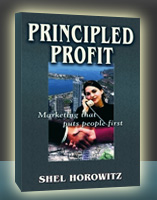|
|
|
I talk to companies all the time about being human at a distance, and how these new social tools allow us to engage in human business, which I consider more relationship-driven than numbers-driven. There are lots of things I mean when I say this, and lots of ways to implement it online. I’ll give a few here as a starting point for your consideration. As we uncover how human business works, these topics are pertinent to how we weave: to move from solo player to interconnected node. Add what you will to this in the comments.
The Basics of Presence
- Faces matter – On all online accounts, use a picture of you, or you with a logo, or you in front of a logo, to represent yourself.
- Backgrounds matter – I realize it’s superficial, but having a custom Twitter background, or using more than a rudimentary blog design, and/or personalizing your platforms of use give off the sign that you’re part of the system, and that you’re there to interact.
- Fill out your bio – Add your name and contact information (and you can choose HOW you want to be contacted) to your various profiles online. Make it easy for people to do business with you.
Conversational Matters
- Make each conversation unique to the platform – By this, I mean that I prefer individual conversations on Facebook that aren’t cloned into Twitter and/or back again. I believe it’s more authentic to be in one place at a time. Even if you say similar things in both places, I prefer it that way than to blanket automated clatter.
- Talk about them – It’s easy to talk about yourself. Listen to what others are saying and reach out to them about them. This gives so much more richness to when you start talking about what you’re into.
- Be the #1 commenter on your blog – If you’re maintaining a blog, be sure to comment back to what people have offered you. It extends the relationship, acknowledges that you’ve seen what they’ve said, and gives people the sense of feeling heard. (I work hard at this, but it’s not always easy when things get busy).
- Be brief – This is easy to accomplish in Twitter, but strive for the same in email, in blogging, in all the ways you seek to connect with people.
- Remember – When someone says their cat is sick, it’s good to make a note to inquire about it later. People like when you remember. It goes far in making a relationship feel two-way, because believe me, they remember about you.
- Ask – Often, if someone is talking a lot about you, they’re hoping (at least a bit) that you’ll return the favor and ask about them. Be sure to do that.
- Be helpful – Conversations are a great starting point to finding out what someone needs, but offer help, not just sales of your products or services. Be genuinely interested in someone else’s success and you’ll find all kinds of reward for this down the road.
Motion and Sound
- Add video to the mix – When I record my videos for book reviews or things like overnight success, I get an overwhelming response back from people. Video has power. I tend to use it as part of my communications deck, because video isn’t yet very well searched by Google, and because people can read text much faster than they can appreciate a video, but it’s there, just the same, because video conveys emotions in ways that text can only emulate.
- Don’t shy away from sound – Using something as simple as BlogTalk Radio is a great way to mix voice and conversation into your online presence and communications plans. It’s just as important, I believe, and gives people lots to go on.
- Pictures help – I use Flickr to share photos of events, of people I meet, of my family, of whatever catches my fancy. I do this also because they connect us, they give us common experience points, they share faces with we humans (who have a thing for faces, if you didn’t know). Pictures are a strong way to add humanity to what you do.
Topics of Conversation
Mixing Personal and Professional – I’m for it. People ask me all the time whether they should talk about personal things on their business account. I say yes, absolutely. But be measured. There’s a huge difference between self-aware and self-involved. In my personal case, I’m lucky. I’m my own brand, so if I want to scare you with tweets about my doctor’s office, I can. You might not be as lucky, but please, in the name of all that is holy, don’t be boring. That’s a worse crime.
Talk about the space, not you – As much as you can, talk about what equips your customers/prospects/audience and not about your stuff. Talk about music and your passion for a certain band if you’re Sonos. That’s what Thomas Meyer does very well. (Hi, Tom)
Share the spotlight – People know you’re awesome. Point out others who are awesome, too. If you can, point out customers and prospects who are awesome. They appreciate the attention, too. The point is, it’s not about you.
Talk about great causes – If I could write about causes in every post, I would. Mark Horvath at InvisiblePeople.tv wouldn’t complain (would you, Mark?). This shows that you care, that you want bigger things for the world than just your own personal success. It helps people gauge what matters to you.
Don’t brag – At least not much. People just don’t like bragging. They might accept the occasional self-deprecation-laden quasi-boast, but don’t be that guy. (Man, and don’t retweet when people say something nice about you. It just looks icky.)There are many more ways to talk about, but this is a good enough start.
How else do you think companies and people on the web should learn to be human at a distance?
Chris Brogan is a ten year veteran of using social media and both web and mobile technologies to build digital relationships for businesses, organizations, and individuals. Chris speaks, blogs, writes articles, and makes media of all kinds at [chrisbrogan.com], a blog in the top 10 of the Advertising Age Power150, and in the top 100 on Technorati. He is co-author of the book Trust Agents.
|


 Shel specializes in affordable, ethical, and effective marketing for authors, publishers, small businesses, nonprofits, and community groups. Copywriter, marketing and publishing consultant, international speaker, and award-winning author of seven books.
Shel specializes in affordable, ethical, and effective marketing for authors, publishers, small businesses, nonprofits, and community groups. Copywriter, marketing and publishing consultant, international speaker, and award-winning author of seven books.